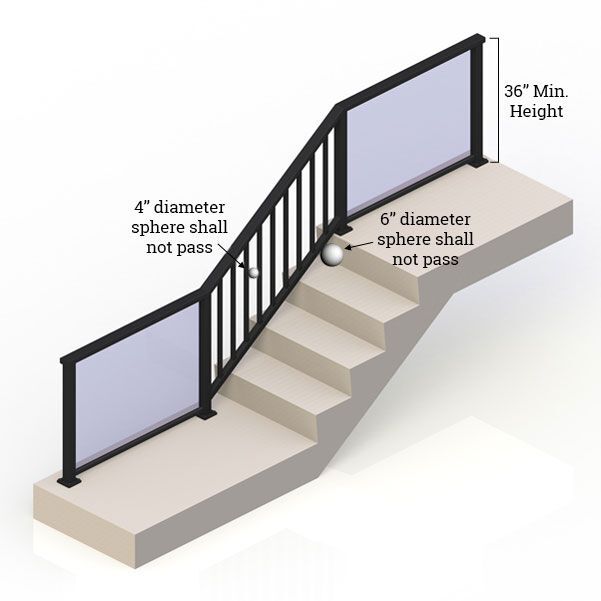Glass Railing Building Codes
 One of the most important things to consider when installing glass railings is the building code for your area. If you are planning to install your eGlass Railing™ system yourself, knowing the building code for your project will help you to avoid costly repairs in order to be in compliance. It can be a challenge trying to figure out what codes and standards to follow, as there are codes that address fire and electrical hazards (NFPA), codes that relate to work environments (OSHA), and codes that address accessibility for persons with disabilities (ADA), as well as model building codes (IRC and IBC) and local building codes.
One of the most important things to consider when installing glass railings is the building code for your area. If you are planning to install your eGlass Railing™ system yourself, knowing the building code for your project will help you to avoid costly repairs in order to be in compliance. It can be a challenge trying to figure out what codes and standards to follow, as there are codes that address fire and electrical hazards (NFPA), codes that relate to work environments (OSHA), and codes that address accessibility for persons with disabilities (ADA), as well as model building codes (IRC and IBC) and local building codes.
Building codes are developed to protect public health and safety. They indicate the standards to which structures should be built in order to prevent illness or injury. While we have done everything we can to engineer our eGlass Railing™ products to meet model building codes, your local building codes may have different provisions to meet. Before you install your railing system, it is best to check with the local authority having jurisdiction (AHJ) because it is local code inspections you will need to pass.
Often building codes and standards address handrails and guardrails (or guards) and, at first glance, these may seem interchangeable, but they have a distinct difference -- handrails are meant to provide guidance, whereas guards are meant to prevent accidental falls. A guard can potentially function as a handrail depending on the height of the guard and the grasp-ability of the top rail. This situation mainly applies to residential railings. However, the IBC requires a guard to be 42" high for commercial railings, which is too high for a handrail (generally between 34" and 38"), so a handrail would need to be added to the guardrail at the appropriate height to meet code. The grasp-ability of the handrail is determined by the diameter of the rail, which should be between 1 1/4" and 2", with some variations for residential railings.
There are different codes to follow depending on whether you are installing glass railings in a residential (either a one or two-family dwelling) or commercial or multi-family residential building. The model code for a residential building is the International Residential Code (IRC), while the model code for commercial buildings is the International Building Code (IBC). Both of these model codes are updated every three years and fall under the International Code Council (ICC), providing minimum safeguards for people at home, school, and in the workplace.
While the IRC/IBC are foundational building codes, there are other building codes, guidelines, and standards that may need to be considered depending on where you plan to install your glass railing. The majority of these relate to commercial buildings, however, there are some that address residential buildings which makes it prudent to review them and also to check with your local building code office to assure compliance.
The National Fire Protection Association (NFPA) has developed more than 300 consensus codes and standards that focus on eliminating death, injury, property, and economic loss due to fire, electrical, and related hazards. The two code provisions with relevant information in regards to installing glass railings are NFPA 5000: Building Construction and Safety Code and NFPA 101: Life Safety Code. These provisions address handrail clearance, particularly along a fire exit or fire stairs. NFPA codes are overseen and enforced by local fire marshals, not building inspectors, making it especially important to confirm the requirements before installing the railing.
The Occupational Safety and Health Administration (OSHA) is a government agency that sets and enforces standards to make workplaces more safe and healthy. The 1910.29 Fall Protection Systems and Falling Object Protection section applies to glass railing installation as it relates to handrails and guards in workplaces.
Another area of consideration when installing glass railings, especially for commercial buildings, is disabled person access. The main reference that addresses accessibility for those with disabilities is the ICC/ANSI A117.1, Accessible and Usable Buildings and Facilities guide, particularly section 505 that discusses guidelines and standards for handrails. Other references that relate to accessibility are the Americans With Disabilities Act Accessibility Guidelines (ADAAG) and ADA Standards for Accessible Design (ADASAD). Many of the elements of the ADAAG and ADASAD have been integrated into building codes, however, ADASAD is not a building code. ADASAD determines whether a building that is open to the public can be considered accessible for those with disabilities.
Although many of these codes and guidelines will not affect your particular glass railing installation, knowing what the codes and guidelines are can assist you in both selecting an appropriate railing for your project and in installing it properly to meet the codes of your local area. It is far less time consuming and less expensive to install a project properly from the beginning rather than having to correct it later to make sure you are in compliance with local building codes.
